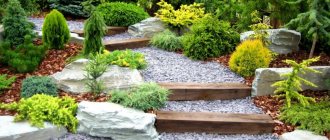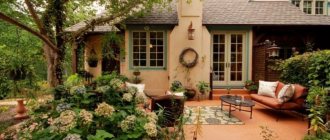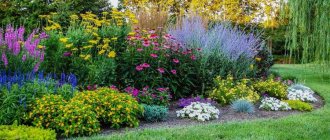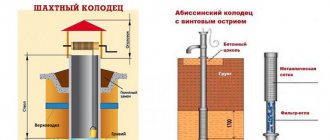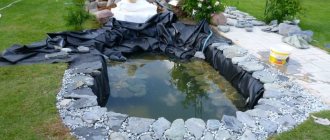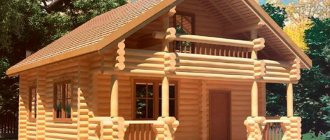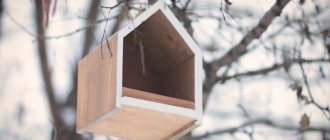Home » Landscape design » Flower beds and flower beds
Flower beds and flower beds
Vladimir 05/07/2020
68666 Views
SavingSavedRemoved 4
Do-it-yourself flowerbeds in the country
The flower garden is a small architectural wonder surrounded by emerald green grass. Flower beds include both single and group plantings, decorative elements, paths, platforms, small architectural forms in the form of sculptures, fountains, etc. Join the fascinating world of landscape design - create a flowerbed at your dacha with your own hands!
Introduction
Based on your wishes, you can create the flower garden of your dreams with your own hands.
Parterre (geometric) flower beds have a symmetrical shape and are usually located in front of the entrance to the building. Open-plan flower beds provide more room for imagination compared to ground floors. They can be designed taking into account the unevenness of the landscape, and installed in a quiet area of the garden, near the pool.
Stone bricks are an excellent solution for zoning
The background for a flower bed, as a rule, is decorative shrubs with attractive foliage colors or small beautifully flowering trees. When creating flower beds, various types of decoration are used: solitaires, rutaria, alpine slides, arches, borders, etc.
Tapeworm is a solitary growing plant that looks spectacular at any time of the year, stands out against the general background of the flowerbed, forming a bright spot. The purpose of a tapeworm is to attract attention. The life of the entire flower garden revolves around the tapeworm.
Dwarf spruce will perfectly cope with the role of tapeworm
For single plantings, use light-loving plants; they can be either annuals or perennials. Among annuals, decorative sunflower, burgundy amaranth, castor bean are good as tapeworms, among biennials - mallow, foxglove, among perennials - queen of shade astilbe, daylily, tree peony.
Parterres
Such flower beds adorned the territory of palace parks centuries ago; today they can be seen in city squares and on the plots of wealthy people. They have a clear structure and careful planning. To create them, plants are selected that can boast of high decorative value. They are planted in dense groups, using them to create simple patterns. Parterres are ancient, elite types of flower beds. They crash in the most visible place in front of the house.
Classic parterre flower beds Source et.aviarydecor.com
Flowerbed, like from a magazine cover
An enviable decoration for your home
First, decide how much time you can devote to flower beds. If at your dacha there is only a flower garden, and you direct all your strength and energy only to it - this is one conversation, but if there is also a vegetable garden, beds with strawberries, potatoes, tomatoes, cucumbers, a berry garden, there will be very little time left for flowers.
Vegetable bed
Sometimes novice gardeners buy an expensive flower in a single copy, plant it in their flowerbed, and then wonder why the flowerbed doesn’t look as attractive as on the covers of glossy magazines?
Dear flower growers, not all plants, even the most beautiful ones, look impressive individually. Use group plantings to create pops of color in your flower garden. This is a wonderful technique for decorating a beautiful flower garden.
Why isn't your flowerbed like the one on the magazine cover? Read below!
For group plantings, take several plants of the same species in different color shades. You can use annual, biennial and perennial crops.
Look how great the band looks in purple. It contains phlox and daylilies, the queen of the garden - the rose and such a simple but sweet field geranium.
When creating group plantings, choose plants with a long flowering period so that they do not lose their decorative effect throughout the season.
There are some plants that look very impressive before and after flowering. Seed pods and foliage remain on them, and they continue to decorate the flowerbed even after the end of their growing season.
In mixed groups there should be a selection in height, plants should not obscure each other, everything should be harmonious.
Place groups in your flowerbed in tiers . The lower tier consists of ground cover and low-growing plants; they look good near paths and alleys.
Primrose is a great option for the bottom tier of your flower bed.
If you decide to place a group near a tree trunk, then retreat 20 -30 cm. Groups can contain from three to ten plants.
Types of flower beds: irregular
At the dacha, the easiest way is to make an irregular flowerbed, which is characterized by a freer design. Flowers in it are arranged in rows or dotted, with several plants in a group. To prevent bald spots from forming in the flower garden, ornamental grasses and grains are sown between large species.
Marking
Making a flower bed is much easier if you first mark it out. Regardless of the size of the future flower garden, the breakdown will greatly facilitate further efforts to create it. For marking you will need sand, pegs and strong twine. The easiest way is to outline the boundaries of a square or rectangular flower bed. Low pegs are driven in at corner points and connected with rope.
Then a groove is dug along straight lines under the twine, and a concrete curb is installed into it.
It is not much more difficult to create a round flowerbed. You need to measure the diameter of the circle and divide the number in half (find the radius). Then a peg is driven into the center of the flower bed, a rope is tied to it (its length is equal to the radius of the circle) with a piece of reinforcement tied to the opposite end of the twine. Having pulled the rope, it is rotated around a stationary peg, while at the same time drawing a line with the end of the reinforcement until the circle closes. To prevent the line from getting worn out, it is marked with a strip of sand, after which a curb is dug in.
Advice. The border can be made from scrap materials, for example, old brick. It is laid according to the domino principle, that is, obliquely one on one.
Soil preparation
In the fall, preparation of the site for spring planting of seedlings begins. First, the type of soil is determined and, if necessary, improved. For each type of soil, different additives are used, which are evenly distributed over the surface of the future flower garden, and then it is dug deep.
Floral arrays
Unlike the group, the massif occupies a large area that can extend for tens of square kilometers. Arrays can be plain or variegated.
Suitable for single-color arrays:
- lavender
- phlox
- poppies
- tulips
Floral array of tulips of different varieties
It is not easy to create a high-quality massive planting. It should be harmonious, the colors should complement each other. For example, an array of blue pansies, which are located in the foreground, gradually turning into more saturated blue irises.
Contrasting array without further ado
Creation of contrasting arrays is allowed.
The following options are possible:
- pink phlox and white delphiniums
- delicate white daffodils and bright red peonies
- fiery swimsuit and purple cockerels
We create a rock garden on a summer cottage
We have already mentioned today one of the new designs of flower beds in the country. The presented model is a hybrid of a rocky garden with coniferous crops. We present step-by-step instructions for gardeners:
- We are selecting an area for our future flower garden. We clear it of weeds and debris, possible metal objects and splinters.
- We lay a sheet of textile on the ground, which will further prevent the growth of weeds.
- We lay large boulders on top of the textile in a chaotic manner.
- Between them we place pebbles and smaller stones.
- All free space is filled with gravel or crushed stone at your discretion.
- Finally, plants are planted in small areas of soil. Most often, these are coniferous crops, decorative onions, and sedums.
- The plants in this flower garden model play a decorative, auxiliary role, so abundant planting of flower crops is not provided.
Flower garden care is carried out as usual.
Flowerbeds are part of the flower garden
Flowerbeds can be placed in the center of the lawn, along the garden path, around a pool or fountain. They can be oval, round, diamond-shaped or polygonal. Nowadays it is customary to make flower beds flush with the lawn or even deepen them a little.
Play with small architectural forms: statues, fountains
Carpet flower beds made from ground cover plants of various colors in the form of ornaments look very beautiful. It is customary to mulch the soil between plants with sawdust and pine needles.
Video description
The video shows small-sized flower beds that fill large areas and create flowering islands with minimal care:
Against the background of green lawns, spot flower beds created with the help of lush plants (hydrangeas, irises, peonies, rhododendrons) look most impressive. Carpet beds are also extremely good in this situation. You can play with color, with the size of the flower beds, with their shapes.
Flower beds-islands made in the shape of the American flag Source pinterest.com
Border
An important element is the border surrounding the flowerbed. The border gives the flower garden completeness. You can also make a “living” border from low, brightly flowering annual plants, such as marigolds or low-growing begonias.
The border neatly outlines the flowerbed, giving it completeness
When selecting planting material, you need to proceed from the following considerations:
1 the plant must be dense and bushy
2all plants must be the same height
3maintain its attractiveness after flowering
4easy to tolerate trimming
5be resistant to temperature changes
Petunia flower border
Options for borders
Annual plants:
- lobelia
- Chernobrivtsy
- low growing carnation
- fuchsia
- cineraria
- brachycoma
Perennials:
- catchment area
- host
- day-lily
- Heuchera
Selection of plants by height
- Low-growing: adonis vernacular, arabis, pansy, periwinkle, Iberian, Carpathian bellflower, pterophyte, forget-me-not, saxifrage, poppies, aubrieta, primrose, petunia, Lydian and white sedum, cushion phlox, hosta, edelweiss.
- Medium: aquilegia, aster, cornflower, elecampane, swimsuit, delphinium, bellflower, daylily, oriental poppy, narcissus, peony, tulip, phlox, ash.
- Tall: Japanese anemone, yellow hepatica, asparagus, iris, mallow, groundsel, cornflower, foxglove, chrysanthemum, echinacea.
Rabatka
A rabatka is a long strip of land planted with ornamental plants.
Rabatki are good for arranging garden paths and alleys
They highlight the foundation of the building well. As a rule, ridges are not wide up to 2.5 meters.
There is no need to do very long work. If you need to plant a fairly large area, then simply make gaps of half a meter between the ridges.
Plant the gaps with low-growing shrubs: boxwood, spirea.
According to the height of the plants, ridge plants are divided into two types:
1 One-sided - in this case, low plants are planted on the front side of the ridge, then taller ones and, finally, the tallest ones in the background.
2 Double-sided - in this case, tall plants are located in the center, and low plants are located at the edges.
According to the color scheme, discounts are divided into single-color and multi-color.
When creating single-color flower beds, garden plants of the same type and color range are used. In multi-color discounts, you can combine different colors at certain intervals. Multi-colored discounts are more attractive and elegant.
Assortment of plants for an attractive garden
Annuals:
- Chernobrivtsy
- petunia
- brachycoma
A flower bed of ground cover plants along the garden path
Biennials:
- pansies
- daisies
- rose stem (mallow)
It is not easy to create work from perennial plants.
Varietal composition for perennial ridges:
- low growing aster
- tree peony
- delphinium
- day-lily
- Heuchera
- small petal
Roccary
This type of flower bed is rightfully considered one of the most beautiful ways to decorate a flower bed; in appearance, such a flower bed resembles an alpine hill.
Also, a flower bed can be made not only from flowers, but flower beds are also made from stones.
Mixborders
Combined mixborder along the fence
Mixborders are multi-row flower beds of ornamental plants . The plants are selected so that when some fade, others immediately bloom, and the mixborder remains attractive throughout the season.
A flower bed that is attractive in the off-season is the pinnacle of a florist's skill
Mixborders are often placed along buildings, on lawns, and near swimming pools in the form of bright color spots. The edges of the mixborder are limited to lawn grass or laid out with tiles, stones, and stump cuts.
Perennial cereal grasses look beautiful in mixborders
The selection of plants should be such that the flower garden will be a decoration throughout the entire summer season. For mixborders, annuals and biennials are used, but the main place, of course, belongs to perennial plants.
Use pebbles to fill empty spaces between plants
The background for a mixborder can be:
- pampas grass bush
- tree peony
- barberry
- dogwood
- small beautiful flowering tree
Combined mixborder along the fence
Tips for decorating a flower bed
It is true that experience comes with time. But I don’t want to learn from my mistakes. To make the design of your first flowerbed go more smoothly, it is better to listen to the advice of experienced flower growers.
Tips for beginners:
- It is better to make several small flower beds than one large one, since a small flower garden is easier to care for;
- In a flower garden that is too long, it is difficult to take in distant details;
- The diameter of a medium-sized round flower bed is about 2 m;
- A round flower bed looks more impressive when its central part is slightly raised;
- If the flower bed is made on a lawn, it should not be limited by a concrete or any other border. It is better to make a border of low annuals - this way it will look more natural.
- To prevent lawn grass from encroaching on the territory of the flower garden, a plastic border tape is dug along its perimeter;
- You should not save money by planting plants too densely, as they will stretch out and bloom poorly;
- Diseases develop faster in plantings that are too dense.
A few words should be said about rhizome plants. Their root system grows quickly, so every 3-4 years the flower garden is updated or reconstructed. In autumn or early spring, overgrown species are dug up, the roots are divided into sections, and updated planting material is replanted in place. To prevent the process from being too tedious and taking several days, you can separate the most overgrown species every year. It should be noted that some perennial plants, such as irises, divide from June (when the flowering period ends) until the end of summer.
Useful video on forming a simple flower bed:
Alpine slide
This is a miniature rock garden. The main task when constructing a rock garden is to ensure that it fits organically into the landscape . It is worth remembering that this style of garden art originated in ancient Japan.
The Japanese, above all, value harmony and peace
Alpine slides have gained unprecedented popularity in our time. Apparently our people lack quiet contemplation of natural beauty.
Making a good rock garden is not as easy as it seems at first glance
Planning should proceed in several stages. First of all, it is necessary to organize there is natural planning; it, as it were, stylizes the motifs of the mountain landscape.
- Choose areas with a slope or terraces.
- First, drainage is done, because mountain plants do not tolerate stagnant water.
- The top layer of soil is removed, buried 20–25 cm, crushed stone or broken brick 5–10 cm thick is laid.
- The stones should be matched in color and laid parallel to the surface of the site; stones should not be piled up chaotically.
- Use sandstone, limestone, granite, natural stones. Avoid regular shapes and right angles.
- The stones need to be installed firmly, because in the future it will be possible to move along them, weeding and loosening the rock garden.
- Fill the space between the stones with decorative pebbles or mulch with large sawdust and pine needles.
Stones are an integral part of the alpine slide
Install the stones firmly, you will have to climb on them while weeding the alpine slide
Video description
If you want to understand the question of what mixborders are, watch the video:
Mixborders can be made using conifers of various dwarf species and interspersed with areas covered with light marble chips; you can use herbaceous perennials or annual flowers for the designated purposes. The main thing is that the appearance of the object fits perfectly into the chosen stylistic concept and is an integral part of it. Framing a mixborder can highlight the direction of landscape design.
Bright flat mixborder Source saccaldesignhouse.com
Laying a rock garden
If the plants you plan to plant like acidic soil, add peat chips, and if they prefer alkaline soil types, then you need to lim the soil with lime.
It is not recommended to use manure and large amounts of nitrogen fertilizers, as the plants will begin to vegetate wildly, this will give them an unusual appearance, they will stretch out, become unstable to diseases and lower temperatures.
In addition, manure can contain a huge amount of weed seeds, and as you know, weeds are the worst enemies of flower beds.
Early flowering crocuses take pride of place on alpine hills
In the first 2 - 3 years you can not apply fertilizers at all; in subsequent years you need to add a little superphosphate.
The range of plants used for alpine slides is very wide
Cereals:
- ground cover plants
- all kinds of bells (Carpathian bellflower, Campanula angustifolia)
- Heuchera
- looked younger
- bloodroot
- saxifrage
- savory
- lavender
From early flowering plants you can plant:
- crocuses
- saffron
- decorative bow
- hazel grouse
- hyacinths
Single growing ferns will look beautiful.
Among the shrubs there are many attractive low plants that are suitable for decorating an alpine slide:
- barberry
- heather
- rhododendron
- low growing spirea
- euonymus
- boxwood
Sedum and young - a standard set for a top-end rock garden
Coniferous plants look beautiful: decorative low-growing Christmas trees, pines, yew, juniper.
List of perennial plants for flower beds
- In spring you will be pleased with the blooming snowdrops, crocuses, hyacinths, pushkinias, tulips, primroses, and daisies.
- Carnations, irises, cornflowers, bells, lilies, and peonies are perfect for flowering in summer.
- For autumn, choose chrysanthemums, asters, and sunflowers.
- Use plants that do not bloom during a certain period. Conifers, shrubs, cereals.
Perennials in flower beds
Take care to get the greatest effect from the least amount of labor. There is a way out - these are perennial plants. Even at the planning stage, allocate space for a flower bed.
If you expect that the flowerbed should be visible from the window of the house or from the gazebo, do not hide the flowers away from recreation areas . It is up to you to create a flowerbed of any shape - round, with right angles, in the form of diverging rays.
Perennial plants are a good choice for mixborders
Perennials look very beautiful as part of mixborders - these are prefabricated flower beds. They are usually organized along garden paths or along fences.
Perennial flowers are demanding of sunlight, under the canopy of trees, in the twilight they turn yellow, stretch out, and lose their beauty
Mixborders can be placed next to perennial fruit trees and berry bushes.
When laying a mixborder, keep in mind that its width must be at least two meters, otherwise the attractiveness will be reduced.
DIY flowerbed decorations
The flowerbed will look more advantageous if it is supplemented with non-floral decoration. Tires, wooden stumps and driftwood, old clocks, vases, mirrors are often used for decoration, arches are decorated, statues and sculptures are installed, and mini-fountains.
Create a fence for the flowerbed, decorate the flowerbed with lanterns and lamps that are charged by sunlight during the day, use gravel of various colors for decoration.
Soil preparation
It is advisable to prepare the soil 3 to 5 weeks before planting flowers in the flower bed
- Provide good drainage. Standing water negatively affects the physiology of flowering plants.
- Perennial plants can go into a state of suspended animation due to waterlogging.
- There must be air in the soil, the soil must be moisture-absorbing and fertilized.
- If there are a large number of weeds, you need to remove them, dig up the ground, and get rid of the roots of perennial grasses, especially the rhizomes of creeping wheatgrass.
- Organize drainage, lay it to a depth of a couple of bayonets of a shovel.
- Compost, humus, and peat chips have a beneficial effect on the quality of the soil.
- If your site has clay soil, you need to add sand and half-rotten sawdust.
Fencing made of wooden pegs
For a summer cottage, a great idea would be to fence a flower bed with wooden pegs. At dachas, old branches often appear, from which you can cut into bars to create the border of a flower bed.
Flower beds made of logs are certainly less durable than brick and stone ones. But logs have a unique charm; if you install them correctly and use durable wood, you can enjoy beautiful flower beds for a long time. For outlines, you can use short 30-centimeter round logs, which need to be sharpened at one end and beveled at the other.
The posts must be reliably protected from moisture by impregnating them with special wood products.
Work order:
- The work of laying out a flower bed begins with preparing the site.
- Then a ditch is dug for the posts, about 30 cm deep. Before placing the wooden posts in them, the pits are filled with a dry mixture of sand and cement.
- After filling the hole with a mixture of sand and cement (2 bags of cement per 1 m³ of sand), pegs are stuck in.
- The pegs are then carefully compacted.
- At the final stage, the pits are filled with earth and the soil is compacted.
Attention! If the area is poorly permeable, it is advisable to pour a 10-15 cm drainage layer of gravel, covered with geotextile on top, before laying the sand layer. Proper drainage is important for the longevity of a flower garden.
Planting flowers in a flower bed
The best time for planting flowers is spring, and for bulbous and early-flowering perennials, autumn
1Irises should be replanted after they have flowered, this is the most favorable time, they are at rest, and after a month and a half they begin to grow a new root system.
2When planting perennial plants, remember that the planting holes should be such that the plants can easily spread their roots into them.
3The depth should not be excessively large; the best option is when the lump is completely located in the new hole.
4Freshly dug soil around the planted plant should be compacted, eliminating voids in the area where the root system is located.
5It happens that after the first watering the soil sags; in this case, add fresh soil.
6Leave a small depression to make it convenient to water the plant.
Generalization on the topic
The types of flower arrangements described in the article are the basics that are used to create new genres. Fashion trends encourage landscape designers to come up with something original. And these products always amaze and arouse special curiosity. Just recently, everyone was surprised by the bright compositions with which sundials were created. In them, the flowers opened their buds strictly according to the clock: some bloomed, others closed. Today you can see flower beds that look like sweet cakes, flower topiaries, multi-dimensional 3D flower paintings. Three-dimensional figures, screens, walls – there are no limits to the designers’ imagination. And it pleases.
Ratings 0
Watering
The best time to water is early morning
In summer, perennial flowers need to be watered often and in large quantities. If they lack moisture, they will bloom poorly and will not have the desired aesthetic effect.
Do not water the plants on the leaves, pour water directly under the roots, this way you will avoid the spread of powdery mildew.
Do not forget to remove faded branches, inflorescences, and leaves that have lost their attractiveness. Try to keep your flowerbed decorative for as long as possible.
Basics of care
Plants in irregular flowerbeds begin to be cared for immediately after planting the seedlings. Timely watering is needed. We must not forget about loosening the soil after moistening. When the plants are fully rooted, weed and water as needed.
It is important not to miss the budding period of the flowerbed components. At this time, the plants are fertilized. Use complex fertilizer. Fertilizer is applied in liquid form at the root.
It is permissible to use a sprinkler system. In the fall, humus or compost is added to the empty site.
During the flowering period, it is important to regularly inspect the plants. It is necessary to promptly remove weak specimens and wilted flowers. Healthy, strong plants will produce more buds.
Layout
Perennials are grouped by growth, flowering time, color, and type of leaves. Choose plants that are not particularly labor-intensive to care for.
Moderately labor-intensive perennials include:
- astilbe
- aster
- geranium
- primrose
- brachycoma
- cloves
- sedum
Foxglove requires virtually no care
Among the unpretentious ones the most popular are:
- monarda
- stock-rose
- digitalis
- lily of the valley
- digitalis
- lavender
- phlox
- lovage
Unique scheme for all flower beds
We have already mentioned that flower crops must be combined with each other. After all, the concepts of competition and compatibility always remain relevant.
Competition for moisture in the soil, incompatibility in soil acidity, and shade-loving plants will not be able to exist in open space. Considering these rules, you can achieve excellent results.
Ornamental grass: review of the best decor options and instructions for using ornamental grass (170 photos)How to design a flowerbed - instructions, diagrams, types and options for proper placement of a flowerbed (140 photos)
- DIY flower beds - 180 photos of unusual ideas for beginners and features of their application
However, there is a single model for all flower beds. It does not stipulate the subtleties of caring for each plant, but there are features that will help you properly organize your flower garden yourself. So, the diagram of the flower garden at the dacha:
- A flower garden has a certain area and a layer of soil. The point is that before creating a flower bed, the gardener must find a suitable place, find out the acidity of the soil, fertilize the soil and only then proceed with further work.
- Each palisade has a fence or border. Even if you use a border covered with soil, it should be there anyway. Tiles, stone, wooden blocks - it doesn't matter what material you use. Another thing is important: the additional layer will stop the excessive growth of the root system and weaving plants.
- There is always a central figure. This is a flower crop with maximum growth, unpretentious in care, and does not compete with other plants for moisture and minerals.
- Compliance with the principle of building tiers. You cannot plant low-growing crops in the central circle and fence them with tall bushes. The structure of the flower garden will quickly be disrupted due to the death of climbing and dwarf plants.
Formation of compositions
When arranging flower beds, assume that the main colors are red, blue and yellow.
Flower beds with plants of the same color, but in different shades, look beautiful
Green, purple, and blue flowers look beautiful in the foreground. Cool shades are perceived better up close, because the further they are located, the less impression they will make and will merge with the surrounding landscape.
Also, when creating flower beds, use white color, plants with silver foliage, they look very impressive and, as it were, soften the impression of contrasting neighbors. When creating flower beds, the emotional side is very important, how the plant is perceived by us, people.
The aesthetic side is one of the most important in creating flower beds
Look at the peonies, how luxurious they are, large, majestic, covered in drops of dew, almost the size of a saucer, heavy with the abundance of petals. Forget-me-nots and viola will look beautiful next to peonies.
It is necessary to plant these crops in the most accessible places in your garden; peonies have few competitors that would look so decorative.
Peony bushes need space and green lawns
In early spring, the burgundy sprouts of these flowers look attractive and elegant. After flowering, the bush keeps its shape for a long time and even in autumn pleases with its yellow, red and brown colors, standing out against the background of the lawn and shrubs.
Main conclusions and wishes
We have reviewed with you seven options for available materials from which you can make flower beds for your dacha with your own hands, without spending significant financial resources and physical effort.
As I said at the beginning of the article, I did not offer you complex flower bed designs that require professional knowledge and skills. You need to start simple. And not everyone is ready to invest significant funds in its arrangement at an ordinary, not cool dacha.
But if you want to take more seriously your garden or summer cottage, then I highly recommend using the useful materials from the “ Garden in a New Way ” online school. Its creator is a professional gardener, the author of training courses on working with plants in her garden, Natalya Myagkova.
She graduated from the Timiryazev Academy in the Department of Landscape Architecture and has been doing what she loves professionally for almost 20 years.
In particular, she has two useful training courses on how to independently create original hedges and lawns in your dacha or garden plot. They explain everything in great detail, but at the same time simply and clearly.
So, don't stop there!
By the way, if you have a desire to gain basic knowledge in landscape design, I recommend reading my article Do-it-yourself landscape design for beginners.
I think this will be useful to any summer resident or owner of a personal plot.
Good luck to you in realizing your creative plans!
Subscribe to the latest articles on my website and receive useful information first-hand. The article subscription form is located at the top right.
Best regards, Alexander Tkachenko.
Primroses
One of the first flowers after the snow melts
- Bulbous flowers evoke tender and tremulous feelings; these are the first flowers after winter that we have been waiting for for so long.
- They look touching against the backdrop of the remnants of snow; they should be placed closer to paths and garden paths so that you can admire them.
- Make sure your garden looks decorative from early spring to late autumn. Yes, it's difficult, but possible.
- Take into account all the features, remember that early flowering plants are usually short, so they will need a good background to highlight their beauty.
- Use boxwood bushes, low-growing thuja or juniper as a background.
Plastic bottles - a flight of fancy
Plastic bottles left over after feasts can also be useful to flower bed decorators. Inserted like glass bottles, carefully painted in different colors, they will illuminate the green space with bright notes.
However, it is worth remembering that plastic is subject to deformation when the temperature changes, so before directly inserting the bottles into the ground, you should carefully fill them with sand. Possible deformation under the influence of weather conditions is a disadvantage of these fences.
Beautiful and well-groomed flower garden with a fence made of plastic bottles
The garden plot on which the flower beds are located always attracts attention with its beauty and unique aroma.
climbing plants
In flower beds, climbing plants are located on supports, usually in the center
- Lianas and climbing plants are always welcome guests in the garden. They are distinguished by rapid growth of shoots, carved foliage, numerous flowers, and sometimes attractive fruits.
- To achieve maximum beauty, you need to use supports and create an appropriate background.
- Use combinations of contrasting colors, for example, clematis can be planted in dark purple and white.
- The supports should be comfortable and easy to use.
- Climbing plants can decorate lamp posts and unsightly buildings.
Annuals
Summer is the flowering time for many annual species. You may be thinking about how to make the flower bed in your own garden more attractive looking. You can plant:
- beautiful asters;
- dahlias;
- coreopsis;
- various chrysanthemums;
- calendula.
Related ornamental plants will give a special charm to the selected floral ensemble.
Summer is the flowering time for many annual species.
A vertical flower bed will look great with hanging plants. They give volume and shine, and there are lovely petunias, lobelia and verbena that look great in a vertical bed.
Planting a flower bed - step-by-step instructions
- First of all, you need to draw up a project, make a breakdown, plant plantings. And of course, provide constant care.
- You can make a planting drawing yourself on a piece of paper, or you can use computer programs for landscape design.
- Here is a list of some computer programs for creating flower garden designs.
- After creating a flower garden, you need to write a statement that will contain information about the varieties, hybrids, plants planted, the quantity, and frequency of planting.
- Before planting, it’s a good idea to familiarize yourself with the biology and agricultural techniques for growing certain crops.
- Place flowers taking into account their size, so that they do not block the plants behind them. Consider flowering time.
- If you follow all these rules, the flower garden will look beautiful and attractive from early spring to late autumn.
- Next to bulbous plants that will flower early, tall perennial plants can be provided so that they cover bald spots.
- Once you have finished laying out all the elements in your flower bed, till the soil.
- Don't go beyond the boundaries you set.
- Remove the roots of weeds, especially the rhizomes of creeping wheatgrass, stones, and other debris.
- In case of severe soil contamination, imported soil must be brought in. Remove the top 25 cm layer of soil, fill the vacant space with a specially prepared soil mixture of humus and rotted leaves.
- You can start planting cold-resistant plants in early spring; do not be afraid of frost.
- Start planting heat-loving plants in late May.
- To prevent you from trampling the ground, use boards and stands.
- Planting should be done starting from the center of the flowerbed and gradually moving towards the edges.
- Do not forget that the flower garden must be constantly cared for, only in this case it will look aesthetically pleasing.
- Ensure timely weeding and loosening.
- Faded inflorescences and dry leaves must be removed.
Provide timely watering, and the plants will thank you with lush flowering
- If the summer is especially dry, watering should be done in the morning and evening; watering should not be done during this time.
- Feed the plants with fertilizers three times: in early spring, during bud formation, and during flowering.
- Apply ammonium nitrate, phosphate and potassium fertilizers.
What are there
First of all, let's find out what the difference is between flower beds and flower beds. The flowerbed has clear boundaries and shape: circle, oval, square. Most often it is separated from the rest of the area and raised above it. We most often see this type of landscape design in parks and on the streets.
This is a flowerbed. It has a clear, strictly defined shape and geometrically correctly located plants
A flower garden is any place where plants of any shape are planted. Sometimes it comes with a fence, sometimes it doesn’t. Boxes with flowers hanging on a fence or wall are a flower garden, plants planted in old galoshes are also a flower spot on the lawn and a ribbon along the path are all flower beds.
Let's understand the terms a little. Now about what they are. They are distinguished primarily by flowering time:
- Regular. In them, all plants begin to bloom almost simultaneously. On this basis there are spring, summer, and autumn.
- Irregular - the flowering time is selected so that the flowering of different plants continues from spring to autumn.
Spring flowerbed - all the colors at one time. It is raised - the flowers are planted slightly higher than the soil in the rest of the area
Depending on the type of plants planted, there are annuals, perennials, and mixed ones. In some, only one type of plant is planted. They are called monoflowers or monoflowers.
They can be raised, they are also called high, and they can be multi-tiered. Their construction consists of several stages: first of all, a fence is built, then soil is poured into the finished form and plants are planted.
That's all with theory, let's move on to practice. Let's start with where you can make flower beds and flower beds with your own hands.

